Santa Monica Pier History
The tale of two piers
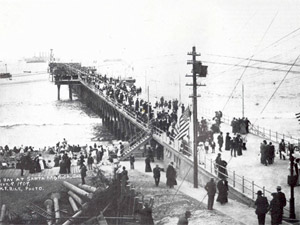 Santa Monica Pier opens in 1909 with thousands of visitors wanting to see the new pier
Santa Monica Pier opens in 1909 with thousands of visitors wanting to see the new pier
In 1909, the famous Santa Monica Pier, now the oldest pleasure pier on the West Coast, was opened attracting thousands of curious visitors. Though the pier was originally constructed with the dubious chore to aid with Santa Monica's sanitation needs, visitors were thrilled to walk above the water along the 1,600-foot long concrete pier. However, there were no attractions or amenities on the stark and narrow municipal pier.
Amusement piers in Santa Monica Bay were all the rage in the early 1900s. Pier owners competed against each other for the best performing roller coasters and greatest attractions. In all, there were six piers along the Santa Monica and Venice Beach shores. The idea of building an amusement pier in Santa Monica attracted Charles Looff, a world-renowned amusement park entrepreneur. Looff was a master carver and builder of carousels and amusement rides and built the first carousel at Coney Island in 1876.
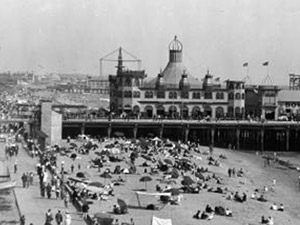 The Looff Hippodrome on the Santa Monica Pier
The Looff Hippodrome on the Santa Monica Pier
Looff purchased the land just south of the pier and started construction of a new pier alongside of the Santa Monica Municipal Pier in 1916. The new pier was the first amusement pier on Santa Monica's north beach and featured amusement rides that included the Blue Streak Racer roller coaster. Looff then proposed to the city government that the Municipal Pier and the Looff''s Amusement Pier be merged and the two piers became one. Charles Looff passed away in 1918 at the age of 66 and his family took over the management of the pier.
The now famous Santa Monica Carousel is the third carousel in the same location at the Looff Hippodrome. Charles Looff installed a Looff Carousel in the building in 1916 which was sold in 1939. It was replaced by a Parker Carousel and sold in 1947. The present carousel, a Philadelphia Toboggan Carousel, whch was on the Venice Amusement Pier, was moved to the building 1947. It originalhy had been built for a Tennessee Amusement park in 1922 featuring 44 magnificent hand-carved and hand-painted wooden horses. The horses performed their never-ending dance around the merry-go-round to the sound of an automated band. The carousal has been beautifully restored is now still fully operational and entertaining the young and young of heart.
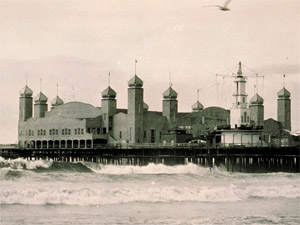 The La Monica Ballroom domanates the Santa Monica Pier in 1924
The La Monica Ballroom domanates the Santa Monica Pier in 1924
In 1923 the Looff family decided to sell the pier to the Santa Monica Amusement Company. The Santa Monica Amusement Company consisted of local businessmen and expanded the pier's thrill rides, replacing the Blue Streak Racer with the larger and faster eighty-foot high Whirlwind Dipper rollercoaster. They also built the La Monica Ballroom which opened on the Santa Monica Pier in 1924. It was a massive ballroom with a 15,000 square foot hard wood dance floor capable of accommodating 5,000 dancers. The La Monica Ballroom had the honor of being the largest dance floor on the West Coast.
A great storm in 1926 put the ballroom and the pier in peril of destruction. The storm washed away two-thirds of the pilings required to support the weight of the huge La Monica Ballroom. Plans to improve the pier where put on hold, as it was necessary to make emergency repairs to the pier. In 1948, Spade Cooley, a country swing music star, televised his weekly TV show in the ballroom, making that the first time that a musical show was televised live. The grand ballroom became a roller skating rink in 1958. Due to overuse and exposure to the elements the ballroom was showing its age and was eventually torn down in 1962.
The Thirties saw the rise of the Santa Monica Yacht Harbor. A breakwater was constructed so boats could be safely moored and to also protect the pier. A collection of yachts, fishing boats and a cruise liner to Catalina made the yacht harbor their home base. However, the breakwater was poorly engineered and began to sink into the sandy ocean floor and it is almost completely submerged today. With Marina del Rey, the worlds' largest man-made pleasure boat harbor opening in 1965 just a few miles south of the pier, signaled the end of boating activities at the Santa Monica Pier.
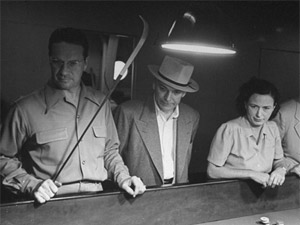 Tony Cornero working the table on his gambling ship, photo courtesy of Time & Life Pictures
Tony Cornero working the table on his gambling ship, photo courtesy of Time & Life Pictures
In 1930 there was a fleet of gambling ships just a few miles off of the Santa Monica Pier. The mobster Tony Cornero operated the most popular of all the gambling ships the S. S. Rex, which was open 24 hours a day with 1,000 to 3,000 gamblers at any one time. The then state Attorney General Earl Warren led a crusade to close all the gambling ships. All the ships were shut down by 1939 except for the Rex. Law enforcement created a siege of the Rex to starve them off. After eight days, Tony Cornero surrendered, he said, "because I need a haircut."
Also in the thirties saw the start of Muscle Beach just south of the Santa Monica Pier. It became widely popular among famous bodybuilders like Jack LaLanne and Joe Gold of Gold's Gym fame. Muscle Beach was actually a project funded by the national Work Projects Administration created by order of President Franklin Roosevelt. Muscle Beach has since moved south to Venice Beach and is now run by the City of Los Angeles Department of Recreation and Parks.
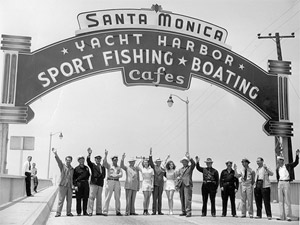 The Santa Monica Sign is installed in 1940 celebrating the Santa Monica Yacht Harbor
The Santa Monica Sign is installed in 1940 celebrating the Santa Monica Yacht Harbor
The famous neon sign at the entrance to the pier was installed in 1940 and since then it has been the icon for Santa Monica City. The sign was erected by the Santa Monica Pier Businessmen's Association to celebrate the opening of the newly built concrete ramp. Though the sign says "Yacht Harbor," there hasn't been a boat moored at the pier for over 40 years. The sign reflects what the pier was at the time it was installed and is cherished by the citizens of Santa Monica.
Walter Newcomb had been managing the Pier's operation for years and finally bought the pier from the Looff family in 1943 and the Looff Amusement Pier became the Newcomb pier. In the 1950s, the Gordon family took over the arcade games on the pier, upon the suggestion of Enid Newcomb. At present, the Gordon family still manages the Playland Arcade, the Pier's longest running business offering modern amusements of today like video games and air hockey along with the popular games of yesteryear like skee-ball and the shooting gallery.
The 1960s saw the final decline of pier amusement parks, mainly because of the appearance of inland theme parks like Disneyland. In the 1970s, Walter Newcomb sold the Pier to the City of Santa Monica. The City Council then proposed the demolition of Santa Monica Pier in favor of a man-made island that would be the home of a resort hotel. The residents of Santa Monica rallied against it and fought to keep the pier. They started the Save Our Pier Forever campaign. The city council created the Pier Restoration Corporation to take charge of rehabilitation efforts, but not much was done. In 1975, the Hippodrome building and carousel were designated as a Los Angeles historical landmark by the US government.
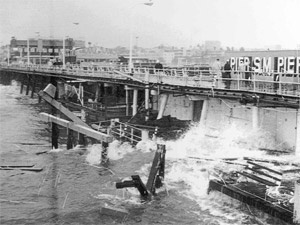 Two violent storms in 1983 destroyed over a third of the Santa Monica Pier.
Two violent storms in 1983 destroyed over a third of the Santa Monica Pier.
Even though the Santa Monica Pier survived over the years, it was poorly kept. The pier and the businesses around the pier took on a dilapidated look. Several studies were done for the redevelopment of the pier but they were never acted upon. It took Mother Nature's hand to get the rehabilitation going. In 1983, two major winter storms due to the El Niño phenomenon destroyed more than a third of the pier. Also destroyed were the cafes, the bait shop and the harbor patrol station at the end of the pier.
Rebuilding the pier took a concerted effort. There was a free concert series during the 1983 Save the Pier Week which accidently started the free summer concerts on Santa Monica Pier. These popular concerts are dubbed the Twilight Dance Series and have been ongoing for over 25 years with an eclectic mix of international and local musicians. The total cost to rebuild the pier was $42 million. The Pier Restoration and Development Task Force, created by the city council, oversaw the reconstruction and the daily operations of the Pier.
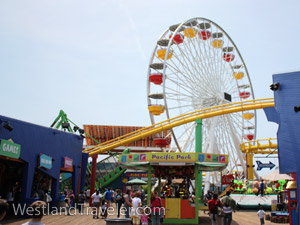 Pacific Park opens on the Santa Monica Pier making it the only admission free amusement park in Southern California
Pacific Park opens on the Santa Monica Pier making it the only admission free amusement park in Southern California
Pacific Park opened in 1996 as a free admission amusement park. Santa Monica Pier had returned to its roots as an amusement pier, it had been over 60 years since the pier hosted the Whirlwind Dipper rollercoaster. Pacific Park has numerous attractions including a Ferris Wheel, a rollercoaster and bumper cars to name a few. Ironically, it is now the only amusement park on the West Coast that is located on a pier.
On September 9, 2009, Santa Monica Pier celebrated its 100th birthday. Santa Monica Pier has indeed come a long way. It stands as a memorial of its glorious past and a statement of many more magnificent years to come.
